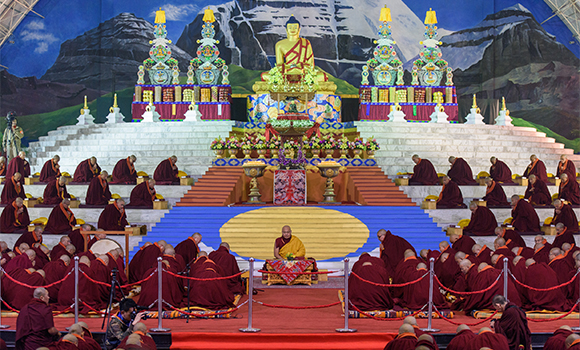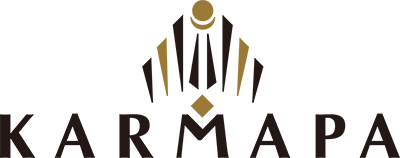
29 December, 2014-12-30 Monlam Pavilion
Clusters of people were already making their way through the security check, when His Holiness arrived at the Monlam Pavilion for the first session of the 32nd Monlam at just turned 5.00am.
A new concrete road, laid specially for the International Buddhist Conclave, held at the Monlam Pavilion in late September, stretches from the Sujata Bypass past Tergar Monastery to the Monlam Pavilion. All those who walk along it pass under the very plain Monlam entrance gate—a simple structure of cloth, painted plywood and bamboo. The same as last year, it bears prayer flags of the dhayani mantra of Akshobhya Buddha, which has the power to purify all those who pass beneath. The right-hand pillar is decorated with the colours associated with Buddhism and used in Buddhist flags. The six colours represent the six colours of the aura which Buddhists believe emanated from the body of the Buddha when he attained enlightenment. Blue represents universal compassion; yellow for the Middle Way; red stands for the blessings of the Dharma; white is for purity, and orange is for wisdom.
The morning was clear, dark and chill. The temperature in the pavilion was below 5◦ C but His Holiness sat facing the assembly without his cloak, dressed only in his robes and chögu , to inaugurate the 32nd Monlam by giving the Mahayana Sojong vows.
He then welcomed everyone.
“As the sacred place of Bodhgaya is the most important place for Buddhists, when we gather here together, we should remember the kindness of our teacher the Buddha”, he said. If we do this it will help increase our roots of virtue.
Everyone makes efforts in accumulating virtue during the year so it was good to meet together at the end of the year to dedicate that virtue and confess our misdeeds. The Monlam only lasted a few days, but during that time people should try to have a different attitude; whatever we do or think, we need to concentrate on virtue, and put effort into Dharma otherwise there will be no results from our dharma practice.
“We are trying to tame our mind, uproot ignorance and the afflictions”, he reminded everyone.
It is not possible to practice Dharma without a plan, so we need a strategy. We need to have an aim for each day, and act in accord with that aim. There is no need to be overwhelmed by the task, just take it step by step.
In conclusion, His Holiness urged, “We have people from more than 50 countries here..we have the four communities…If we make aspirations they will be accomplished quickly. This is a good opportunity that we must not let go to waste.”
As the sun rose, the fog swept in and fingers of mist stretched into the pavilion. The temperature dropped further. People’s breath steamed in front of them and condensation dripped from the iron roof onto some of the unfortunate yet most fortunate people below. Even the combined body heat of more than twelve thousand people couldn’t dispel the cold, though a breakfast of rolls and Tibetan butter tea helped.
Once more, this year, the stage is visually stunning, rich with contrasting shapes and colours, leading the eye upwards from tier to tier until it finally rests on the central figure of the Buddha, resting serenely on the fourth tier against a painted backdrop of Gang Rinpoche [Mount Kailash], the most sacred mountain in Tibet. The Buddha has been clothed in a new silk robe, the edges of the square golden patches delineated in a contrasting deep red.
To left and right the altars stretch towards the wings of the stage, each laden with two huge butter sculptures and cylindrical arrangements of fruit and sweets, in Korean style.
Below, on the third tier is the wooden pagoda style shrine which contains an image of the infant Buddha, circled by garlands of fresh flowers. On the second tier stand two massive butter lamps, donated this year, but instead of oil, circles of smokeless candles burn brightly in them. His Holiness considered this a more environmental friendly option than the usual oil.
There is a change in the seating arrangements this year. Either side of the shrine, and on the deep steps below, sit three rows of Gelongs, facing inwards towards the shrine. During the second session, the teachings from “Freedom from the Four Attachments”, they turned and faced forwards instead, in the direction of Jamgon Kongtrul Rinpoche.
Finally, on a slightly raised seat centre-stage on the first tier, is the heart of the Monlam, His Holiness the 17th Gyalwang Karmapa. To his left sits Gyaltsab Rinpoche, and Jamgon Kongtrul Rinpoche to his right. Behind them sit the other Rinpoches, tulkus, senior khenpos and gelongs.
As always, the flower arrangers have produced magnificent bouquets of huge yellow, white and mauve blooms which grace the lower reaches of the stage.
His Holiness, as is customary, took the role of ritual master during the first part of the morning’s rituals, the Twenty Branches. Following the Refuge and Bodhichitta prayers, His Holiness walked up to the pagoda shrine, donned his ceremonial red and gold hat, and performed the offering rituals which accompany the first nine stages of the Twenty-Branch Monlam, offering incense, bathing the infant Buddha with perfumed water, drying, offering robes, and anointing. Having completed the task, he returned to his seat. The two new state-of-the-art video screens mounted on stands either side at the front of the pavilion enabled everyone in the vast auditorium to watch.
This year’s Kagyu Monlam is the largest gathering so far at a Kagyu Monlam in Bodhgaya, and, for the first time, laypeople outnumber monks and nuns. 4600 monks and nuns have registered, 3400 laypeople from across the Himalayan region, and 3690 foreigners. This brings the total registered to 11,690.
Another first, was inviting the head of another tradition, His Holiness the Sakya Trizin, to give an important empowerment. In addition, this year H.E. Jamgon Kongtrul Rinpoche will assume more responsibility when he delivers the teachings on “Freedom from the Four Attachments” during the second session of the Monlam each day for the first four days.
All the events so far have been webcast. On the first day of the Monlam there were 4,000 unique viewers from approximately 76 countries during the webcast. At any one time there were about 500 viewers. This is of course a count of the computers in use at that time, and does not give an accurate head count. For example, people watching in a dharma centre would only count as one.
This year’s Monlam also includes several services to the community:
A Free Veterinary Camp: For the first time this will include a team assigned to Gaya Town for a day, a village outreach programme and a training programme for local vets.
Free Medical Camps: For the first time this will include clinics in two local villages and a three-day specialist clinic.
Soup Kitchen
Campaign to stop the trade in caged birds


